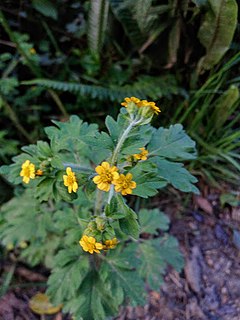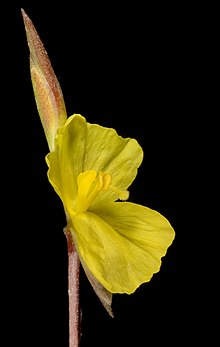
Falconeria is a monotypic plant genus in the family Euphorbiaceae, first described as a genus in 1839. The genus is sometimes included within the genus Sapium. The sole species is Falconeria insignis. The plant is found from India, Nepal, Bangladesh, and Sri Lanka to Indochina, China, Thailand and Peninsular Malaysia.

Micrantheum is a genus of plants under the family Picrodendraceae described as a genus in 1818. It is endemic to Australia.
- Micrantheum demissumF.Muell. - South Australia
- Micrantheum ericoidesDesf. - New South Wales, Queensland
- Micrantheum hexandrumHook.f. - Box Micrantheum - New South Wales, Queensland, Victoria, Tasmania
- Micrantheum serpentinumOrchard - Western Tridentbush - Tasmania
Picrodendron is a genus of plant belonging to the family Picrodendraceae described as a genus in 1859.

Phleum (timothy) is a genus of annual and perennial plants in the grass family. The genus is native to Europe, Asia and north Africa, with one species also in North and South America.

In taxonomy, an undescribed taxon is a taxon that has been discovered, but not yet formally described and named. The various Nomenclature Codes specify the requirements for a new taxon to be validly described and named. Until such a description has been published, the taxon has no formal or official name, although a temporary, informal name is often used. A published scientific name may not fulfil the requirements of the Codes for various reasons. For example, if the taxon was not adequately described, its name is called a nomen nudum. It is possible for a taxon to be "undescribed" for an extensive period of time, even if unofficial descriptions are published.

Helmholtzia is a small genus of flowering plants described in 1866. It includes species native to Australia, Indonesia, and New Guinea.

Rafinesquia, commonly known as plumeseed, is a genus of flowering plants in the dandelion family, native to the western United States and northwestern Mexico.

Iva is a genus of wind-pollinated plants in the daisy family, described as a genus by Linnaeus in 1753. Plants of this genus are known generally as marsh elders. The genus is native to North America.
Wilhelm (Guillermo) Kalbreyer (1847–1912) was a German plant collector who was sent by James Veitch & Sons of Chelsea, London to collect new plants in West Africa and South America.

Eclipta is a genus of flowering plants in the sunflower family.
Lepidophyllum is a genus of South American flowering plants in the daisy family.
The World Checklist of Selected Plant Families is an "international collaborative programme that provides the latest peer reviewed and published opinions on the accepted scientific names and synonyms of selected plant families." Maintained by the Royal Botanic Gardens, Kew, it is available online, allowing searches for the names of families, genera and species, as well as the ability to create checklists.

Irvingia is a genus of African and Southeast Asian trees in the family Irvingiaceae, sometimes known by the common names wild mango, African mango, bush mango, dika or ogbono. They bear edible mango-like fruits, and are especially valued for their fat- and protein-rich nuts.
Huerniopsis is a genus of plants in the Apocynaceae family, first described in 1878. It is native to southern Africa.
- Huerniopsis atrosanguinea(N.E. Br.) A.C. White & B. Sloane - N Botswana
- Huerniopsis decipiensN.E.Br. - Western Cape Province
- Huerniopsis gibbosaNel - Lobatsi in Botswana
- Huerniopsis papillataNel - Debeeti in Botswana
Manothrix is a genus of plants in thefamily Apocynaceae, first described as a genus in 1878. The entire genus is endemic to Brazil.
- Manothrix nodosaMiers
- Manothrix validaMiers

Histiopteris is a genus of ferns in the family Dennstaedtiaceae described as a genus in 1875.

Villanova is a genus of Latin American plants in the sunflower family.

Anthurium warocqueanum, commonly known as the queen anthurium, is a species of plant in the genus Anthurium. Native to Colombia, it is grown in more temperate climates as a greenhouse or houseplant for its long, ornamental foliage.












